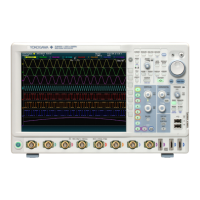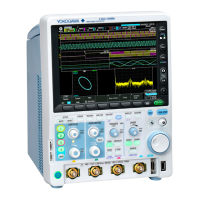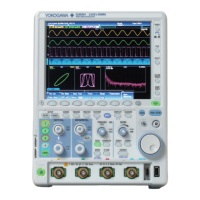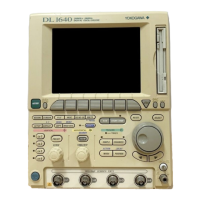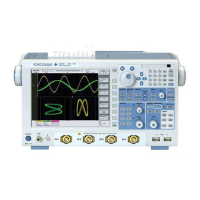5-322
IM DLM4038-17EN
*ESR? (standard Event Status
Register)
Function Queries and clears the standard event register.
Syntax
*ESR?
Example
*ESR?
-> 32
Description • A sum of the values of each bit is returned in
decimal format.
• When an SRQ is generated, you can check
what types of events have occurred.
• For example, if a value of 32 is returned, this
indicates that the standard event register is
set to 00100000. This means that the SRQ
occurred due to a command syntax error.
• A query using
*ESR?
will clear the contents of
the standard event register.
• For information about the standard event
register, see page 6−4
*IDN? (IDeNtify)
Function Queries the DLM4000 model.
Syntax
*IDN?
Example
*IDN?
-> YOKOGAWA,DLM4038,91M835868,F1.01
Description The information is returned in this
form:<Manufacturer>, <Model>, <Serial no.>,
<Firmware version>.
The following values are returned for <Model>:
DLM4038 for the DLM4038 and DLM4058 for the
DLM4058.
*OPC (OPeration Complete)
Function Sets bit 0 (the OPC bit) of the standard event
register to 1 upon the completion of the specified
overlap command.
Syntax
*OPC
Example
*OPC
Description • For information about how to synchronize a
program using
*OPC
, see page 4-8.
• The
:COMMunicate:OPSE
command is used
to specify the overlap command.
• If
*OPC
is not the last command of the message,
its operation is not guaranteed.
5.39 Common Command Group
The commands in this group are defined in USBTMC-USB488 and are independent from the instrument’s individual
functions. There are no front panel keys that correspond to the commands in this group.
*CAL? (CALibrate)
Function Executed calibration and queries the result.
Syntax
*CAL?
Example
*CAL?
-> 0
Description If the calibration terminates normally, 0 is
returned. If an error is detected, 1 is returned
*CLS (CLear Status)
Function Clears the standard event register, extended
event register, and error queue.
Syntax
*CLS
Example
*CLS
Description • If the *CLS command is located immediately
after the program message terminator, the
output queue is also cleared.
• For information about each register and queue,
see chapter 6.
*ESE (standard Event Status Enable
register)
Function Sets or queries the standard event enable
register.
Syntax
*ESE {<NRf>}
*ESE?
<NRf> = 0 to 255
Example
*ESE 251
*ESE?
-> 251
Description • Specify the value as a decimal format sum of
the values of each bit.
• For example, specifying *ESE 251 will cause
the standard enable register to be set to
11111011. In this case, bit 2 of the standard
event register is disabled. This means that bit 5
(ESB) of the status byte register is not set to 1,
even if a query error occurs.
• The default value is *ESE 0 (all bits disabled).
• A query using *ESE? will not clear the contents
of the standard event enable register.
• For information about the standard event enable
register, see page 6−4.
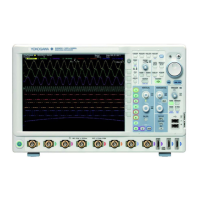
